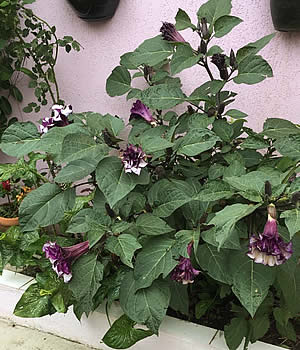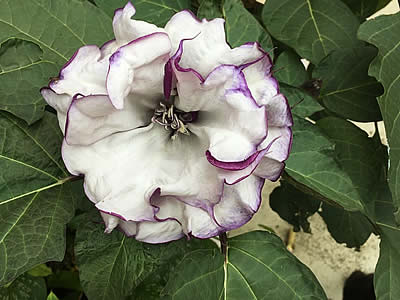
The Horn of Plenty (Datura metel) is a shrubby, herbaceous, flowering, and ornamental plant, known for being as beautiful as it is poisonous. Native to Asia, it has naturalized in various countries, especially under tropical climates. With erect and branched growth, it reaches a height of 0.9 to 3 meters (about 3 to 10 feet), but tends to spread more horizontally than vertically. The leaves are oval, usually glabrous, simple, entire or lobed, alternate, dark green to slightly bluish in color, and release an unpleasant aroma when crushed or pruned.
Flowering occurs from mid-summer to late autumn, featuring terminal, solitary, erect flowers (unlike the Saia-branca (Brugmansia suaveolens), with hanging flowers). They are large, hermaphroditic, trumpet-shaped, and come in single, double, or triple corollas in white, yellow, pink, lilac, or deep purple, with fragrances varying by cultivar.
Each flower lasts for just one day and attracts nocturnal moths, their primary pollinators. The ensuing fruits are round, nodose capsules, not spiny like in other species of the same genus. They are dehiscent, opening upon maturity into four valves and thus releasing numerous seeds.
The Black Daturas of the D. metel ‘Fastuosa’ variety are particularly sought after for garden adornment. They feature black stems, double flowers, mostly purple on the outside and white inside, and are very attractive, as shown in the photos illustrating this article.

In the garden, the horn of plenty is a rustic species, low-maintenance, and versatile. Plant the horn of plenty in well-fertilized beds, in simple rows, next to walls, or in compositions with other plants of different textures and colors, thus creating an interesting contrast. If provided with support, such as small trellises, for example, it can be grown as a climber with some tying.
There’s no need to remove dead flowers, and it can be pruned to renew foliage from year to year. Also plant in pots and planters, adorning patios and balconies, which is very useful in temperate climates, as it can be moved indoors during harsh winters, and then returned outdoors in the spring.
Beyond its obvious ornamental qualities, the horn of plenty is reputed to be simultaneously toxic, medicinal, and magical, common to the Datura species. These plants contain tropane alkaloids, such as scopolamine, hyoscyamine, and atropine, anticholinergic agents that can cause delirium, mydriasis, tachycardia, hyperthermia, amnesia, strange, and even violent behaviors. In high doses, they become a potent poison.
In various cultures, from India, China, and the Americas, the horn of plenty has been used for centuries for these effects, in initiation rituals, shamanism, and also in medicine, mainly to treat asthma and rheumatism. All parts of the plant contain these substances, varying in quantity depending on the organ and age of the plant, as well as the variety, cultivation conditions, etc. Therefore, its use as a medicine is quite controversial and restricted, with difficulty in controlling the dose between treatment and fatal poisoning.
It should be cultivated in full sun or partial shade, in fertile, drainable soil enriched with organic matter, and watered regularly. In temperate climates, this species behaves as an annual. In this case, it is recommended to plant seeds in a greenhouse in mid-winter, and transplant seedlings to their final location after the last frost.
In tropical climates, the horn of plenty is perennial, not requiring annual replanting. Nevertheless, it is not a long-lived species, and from time to time, it will be necessary to renew the beds by adding new seedlings. It is sensitive to intense cold and frosts. Propagation is easily done through seeds and cutting of branches.


